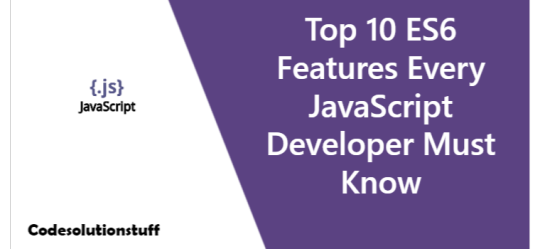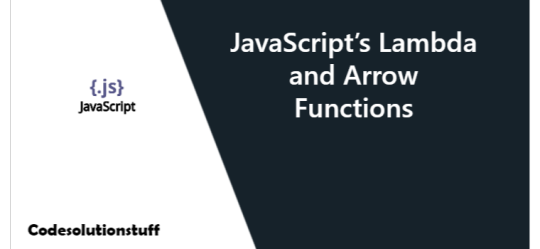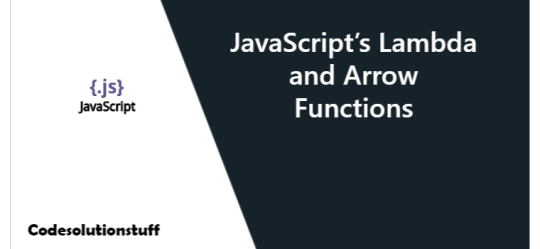#ArrowFunctions
Explore tagged Tumblr posts
Video
youtube
How to show random message in websites #coding #arrowfunctions #softwar...
1 note
·
View note
Text
JavaScript Arrow Functions: A Comprehensive Guide
Mastering JavaScript Arrow Functions! 🚀 From syntax to best practices, dive into this comprehensive guide for all things #JavaScript #ArrowFunctions. Level up your coding skills today! 💻 #Programming #WebDev
Arrow Function Syntax in JavaScriptBasic SyntaxExample:Concise SyntaxArrow Functions Without ParametersLexical thisConsiderationsHow to Convert a Regular Function to an Arrow Function EasilyStep 1: Remove the function KeywordStep 2: Remove the Function Name (If It’s Anonymous)Step 3: Adjust the Function BodyExample:Considerations:Why Arrow Functions Are Recommended Over Regular FunctionsConcise…

View On WordPress
0 notes
Text
Top 10 ES6 Features Every JavaScript Developer Must Know

The most recent iteration of JavaScript was released in 2015 and is called JavaScript ES6 (also known as ECMAScript 2015 or ECMAScript 6). The programming language used by JavaScript is called ECMAScript. The guidelines for how the JavaScript programming language should operate are provided by ECMAScript. We'll go over some of the top ES6 features in this blog that you may utilize in your regular JavaScript code. - What is ES6? - Understanding ES6 Features- let and const keywords - Arrow Functions - Multi-line Strings - Default Parameters - Template Literals - Destructuring Assignment - Enhanced Object Literals - Promises - Classes - Modules - Summary
What is ES6?
The sixth major edition of the ECMAScript language specification standard is known as ES6, or ECMAScript 2015. It has become far more well-liked than the previous edition, ES5, and it defines the standard for the implementation of JavaScript. The JavaScript language has undergone considerable changes as a result of ES6. In order to make writing in JavaScript simpler and more enjoyable, it included a number of new features, including the let and const keywords, the rest and spread operators, template literals, classes, and modules. We'll talk about some of the top and most in-demand ES6 features in this article and how to use them when writing JavaScript on a regular basis. - let and const Keywords - Arrow Functions - Multi-line Strings - Default Parameters - Template Literals - Destructuring Assignment - Enhanced Object Literals - Promises - Classes - Modules
Understanding ES6 Features
1. let and const keywords : Users can define variables using the keyword "let," whereas they can define constants using the keyword "const." In the past, variables were declared by using the top-level keyword "var," which had function scope. It indicates that a variable may be utilized prior to declaration. But, the "let" variables and constants have block scope which is surrounded by curly-braces "{}" and cannot be used before declaration. let i = 10; console.log(i); //Output 10 const PI = 3.14; console.log(PI); //Output 3.14 2. Arrow Functions The Arrow Functions functionality is a part of ES6. By omitting the "function" and "return" keywords, it offers a more succinct syntax for creating function expressions. The fat arrow (=>) notation is used to define arrow functions. // Arrow function let sumOfTwoNumbers = (a, b) => a + b; console.log(sum(10, 20)); // Output 30 It is clear that the declaration of the arrow function does not contain the keywords "return" or "function." When there is precisely one parameter, we can omit the parenthesis; however, when there are zero or several parameters, we must always use them. However, we must enclose the function body in curly brackets ("{}") if it contains several expressions. In order to return the necessary value, we must also utilize the "return" statement. 3. Multi-line Strings Also available in ES6 are Multi-line Strings. Back-ticks(') are used to produce multi-line strings by users. The steps are as follows: let greeting = `Hello World, Greetings to all, Keep Learning and Practicing!` 4. Default Parameters In ES6, users can provide the default values directly in the function signature. However, with ES5, the OR operator was required. //ES6 let calculateArea = function(height = 100, width = 50) { // logic } //ES5 var calculateArea = function(height, width) { height = height || 50; width = width || 80; // logic } 5. Template Literals Very basic string templates and variable placeholders are also new features of ES6. The back-ticked string contains the syntax ${PARAMETER}, which is utilized to use the string template. let name = `My name is ${firstName} ${lastName}` 6. Destructuring Assignment One of the most used ES6 features is destructuring. An expression that makes it simple to separate off values from arrays or properties from objects into separate variables is the destructuring assignment. Destructuring assignment expressions come in two flavours: array destructuring and object destructuring. It can be applied in the ways listed below: //Array Destructuring let fruits = ; let = fruits; // Array destructuring assignment console.log(a, b); //Object Destructuring let person = {name: "Peter", age: 28}; let {name, age} = person; // Object destructuring assignment console.log(name, age); 7. Enhanced Object Literals Enhanced object literals are a feature of ES6 that make it simple to quickly build objects with properties inside curly braces. function getMobile(manufacturer, model, year) { return { manufacturer, model, year } } getMobile("Samsung", "Galaxy", "2020"); 8. Promises Promises are utilized for asynchronous execution in ES6. As shown here, we can combine promise and the arrow function. var asyncCall = new Promise((resolve, reject) => { // do something resolve(); }).then(()=> { console.log('DON!'); }) 9. Classes JavaScript has never before had classes. In ES6, classes are introduced. Classes in other object-oriented languages, such C++, Java, PHP, etc., resemble classes in ES6. But they don't operate in precisely the same manner. By employing the "extends" keyword to implement inheritance, ES6 classes make it easier to construct objects and reuse code effectively. In ES6, we can declare classes by preceding the class name with the new "class" keyword. class UserProfile { constructor(firstName, lastName) { this.firstName = firstName; this.lastName = lastName; } getName() { console.log(`The Full-Name is ${this.firstName} ${this.lastName}`); } } let obj = new UserProfile('John', 'Smith'); obj.getName(); // output: The Full-Name is John Smith 10. Modules Until recently, JavaScript lacked native support for modules. A brand-new function known as modules was added to ES6. Each module is represented by a distinct ".js" file. Variables, functions, classes, and other components can be imported or exported from or to different files and modules by using the "import" or "export" declaration in a module. export var num = 50; export function getName(fullName) { //data }; import {num, getName} from 'module'; console.log(num); // 50 Summary - This post introduced us to ECMAScript 2015, often known as ES6, which establishes the benchmark for JavaScript implementation. - The top 10 ES6 Features that make it so well-liked were also covered in this lesson. - Working with JavaScript is significantly facilitated by ES6's classes, modules, arrow functions, template literals, destructuring assignments, and many other features. Read the full article
0 notes
Text
Arrow Functions
The arrow syntax builds on the syntax of the function expression and provides a shorthand way to declare functions that doesn't require using the function keyword. In fact, in cases where the function body consists of one line of code, we can define it in a single line:
const add = (parameter1, parameter2) => parameter1 + parameter2;
below are some examples of arrow functions and how you can use them for mathematical equations
const divide = (x = 2000, y = 100) => x / y;
What was the aim: ✓ has a function expression called divide ✓ divide divides 2000 by 100
const square = (x = 2) => x * x;
What was the aim: ✓ has an arrow function called square ✓ square arrow function takes one parameter and multiplies it times itself
const add = (a = 3, b = 4) => a + b;
What was the aim: ✓ has an arrow function called add ✓ add arrow function takes two parameters and adds them together
link to my gitHub for this exercise:
https://github.com/nscole/phase-1-arrow-functions.git
0 notes
Photo

Understanding function basics in Javascript. This is our ninth slides set on our Quick guide to JavaScript.In this set we are looking at the very basics of creating functions in Javascript. As we may know, functions are the very basics of any programming language for carrying out actions on various data sets available.In Javascript functions are easy as well as difficult!!. Here am introducing how functions get defined and how statements within them get created using a combination of various data primitives and operators.We are looking at two main ways of defining functions and then going alittle bit down with arrow functions. Enjoy the reading #functions #javascriptfunctions #definingfunctions #functiondeclaration #functionliterals #arrowfunctions #multiparameterarrowfunctions #aingleparameterarrowfunctions #noparameterarrowfunctions #multilinearrowfunctions https://www.instagram.com/p/B86iSGbh3gl/?igshid=18rco35bgji1w
#functions#javascriptfunctions#definingfunctions#functiondeclaration#functionliterals#arrowfunctions#multiparameterarrowfunctions#aingleparameterarrowfunctions#noparameterarrowfunctions#multilinearrowfunctions
0 notes
Text
JavaScript's Lambda and Arrow Functions

The majority of contemporary programming languages support lambda expressions (Python, Ruby, Java…). Simply said, they are expressions that generate functions. First-class functions, which essentially mean sending functions as arguments to other functions or assigning them to variables, are extremely crucial for a programming language to provide. Function expressions in JavaScript prior to ES6 provides us with an anonymous function (a function without a name). var anon = function (a, b) { return a + b }; We now have arrow functions in ES6 that offer a more adaptable syntax as well as some added features and difficulties. // we could write the above example as: var anon = (a, b) => a + b; // or var anon = (a, b) => { return a + b }; // if we only have one parameter we can loose the parentheses var anon = a => a; // and without parameters var () => {} // noop // this looks pretty nice when you change something like: .filter(function (value) {return value % 2 === 0}); // to: .filter(value => value % 2 === 0); The fact that arrow functions lack their own this value is one of their main advantages. This is lexically bound to the scope it is contained in. This suggests that we can bid this awful pattern farewell: class Logger { dumpData(data) { var _this = this; // this dumps data to a file and get the name of the file via a callback dump(data, function (outputFile) { _this.latestLog = outputFile; }); } } // using arrow functions class Logger { dumpData(data) { dump(data, outputFile => this.latestLog = outputFile); } } However, there are a few pitfalls to be aware of: - This should be rather obvious, but since it is lexically bound, there is no way to change it. Neither call() nor apply() will be able to supply a different value for this. - There are no disagreements. (function () {console.log(arguments)})(1, 2); // will output (() => console.log(arguments))(1, 2); - When returning object literals, exercise caution. (() => {foo: 1})() // this will return undefined. 'foo: 1' is interpreted as a statement composed of a label and the literal 1 // the correct way should be wrapping it with parenthesis (() => ({foo: 1}))() // returns Object {foo: 1}
Conclusion
In conclusion, arrow functions are a fantastic addition to the JavaScript language that enable considerably more ergonomic code in a variety of circumstances. They do, however, have advantages and cons, just like any other characteristic. They ought to serve as an additional resource for us. Read the full article
0 notes
Text
JavaScript's Lambda and Arrow Functions

The majority of contemporary programming languages support lambda expressions (Python, Ruby, Java…). Simply said, they are expressions that generate functions. First-class functions, which essentially mean sending functions as arguments to other functions or assigning them to variables, are extremely crucial for a programming language to provide. Function expressions in JavaScript prior to ES6 provides us with an anonymous function (a function without a name). var anon = function (a, b) { return a + b }; We now have arrow functions in ES6 that offer a more adaptable syntax as well as some added features and difficulties. // we could write the above example as: var anon = (a, b) => a + b; // or var anon = (a, b) => { return a + b }; // if we only have one parameter we can loose the parentheses var anon = a => a; // and without parameters var () => {} // noop // this looks pretty nice when you change something like: .filter(function (value) {return value % 2 === 0}); // to: .filter(value => value % 2 === 0); The fact that arrow functions lack their own this value is one of their main advantages. This is lexically bound to the scope it is contained in. This suggests that we can bid this awful pattern farewell: class Logger { dumpData(data) { var _this = this; // this dumps data to a file and get the name of the file via a callback dump(data, function (outputFile) { _this.latestLog = outputFile; }); } } // using arrow functions class Logger { dumpData(data) { dump(data, outputFile => this.latestLog = outputFile); } } However, there are a few pitfalls to be aware of: - This should be rather obvious, but since it is lexically bound, there is no way to change it. Neither call() nor apply() will be able to supply a different value for this. - There are no disagreements. (function () {console.log(arguments)})(1, 2); // will output (() => console.log(arguments))(1, 2); - When returning object literals, exercise caution. (() => {foo: 1})() // this will return undefined. 'foo: 1' is interpreted as a statement composed of a label and the literal 1 // the correct way should be wrapping it with parenthesis (() => ({foo: 1}))() // returns Object {foo: 1}
Conclusion
In conclusion, arrow functions are a fantastic addition to the JavaScript language that enable considerably more ergonomic code in a variety of circumstances. They do, however, have advantages and cons, just like any other characteristic. They ought to serve as an additional resource for us. Read the full article
0 notes
Text
JavaScript's Lambda and Arrow Functions

The majority of contemporary programming languages support lambda expressions (Python, Ruby, Java…). Simply said, they are expressions that generate functions. First-class functions, which essentially mean sending functions as arguments to other functions or assigning them to variables, are extremely crucial for a programming language to provide. Function expressions in JavaScript prior to ES6 provides us with an anonymous function (a function without a name). var anon = function (a, b) { return a + b }; We now have arrow functions in ES6 that offer a more adaptable syntax as well as some added features and difficulties. // we could write the above example as: var anon = (a, b) => a + b; // or var anon = (a, b) => { return a + b }; // if we only have one parameter we can loose the parentheses var anon = a => a; // and without parameters var () => {} // noop // this looks pretty nice when you change something like: .filter(function (value) {return value % 2 === 0}); // to: .filter(value => value % 2 === 0); The fact that arrow functions lack their own this value is one of their main advantages. This is lexically bound to the scope it is contained in. This suggests that we can bid this awful pattern farewell: class Logger { dumpData(data) { var _this = this; // this dumps data to a file and get the name of the file via a callback dump(data, function (outputFile) { _this.latestLog = outputFile; }); } } // using arrow functions class Logger { dumpData(data) { dump(data, outputFile => this.latestLog = outputFile); } } However, there are a few pitfalls to be aware of: - This should be rather obvious, but since it is lexically bound, there is no way to change it. Neither call() nor apply() will be able to supply a different value for this. - There are no disagreements. (function () {console.log(arguments)})(1, 2); // will output (() => console.log(arguments))(1, 2); - When returning object literals, exercise caution. (() => {foo: 1})() // this will return undefined. 'foo: 1' is interpreted as a statement composed of a label and the literal 1 // the correct way should be wrapping it with parenthesis (() => ({foo: 1}))() // returns Object {foo: 1}
Conclusion
In conclusion, arrow functions are a fantastic addition to the JavaScript language that enable considerably more ergonomic code in a variety of circumstances. They do, however, have advantages and cons, just like any other characteristic. They ought to serve as an additional resource for us. Read the full article
0 notes